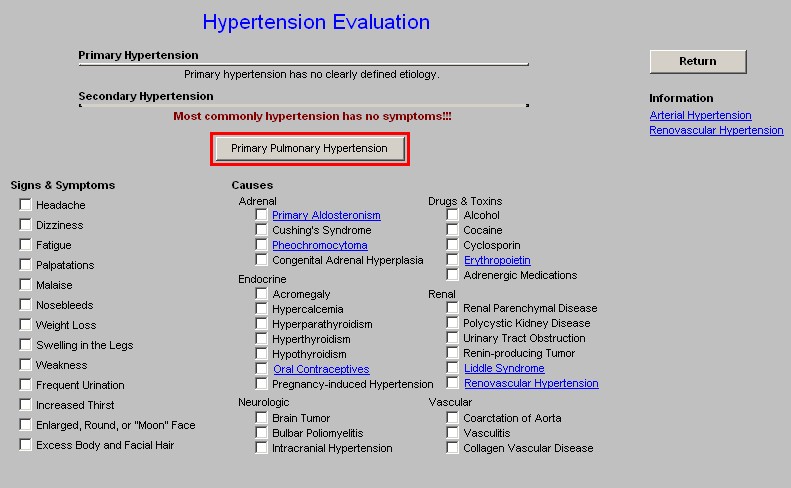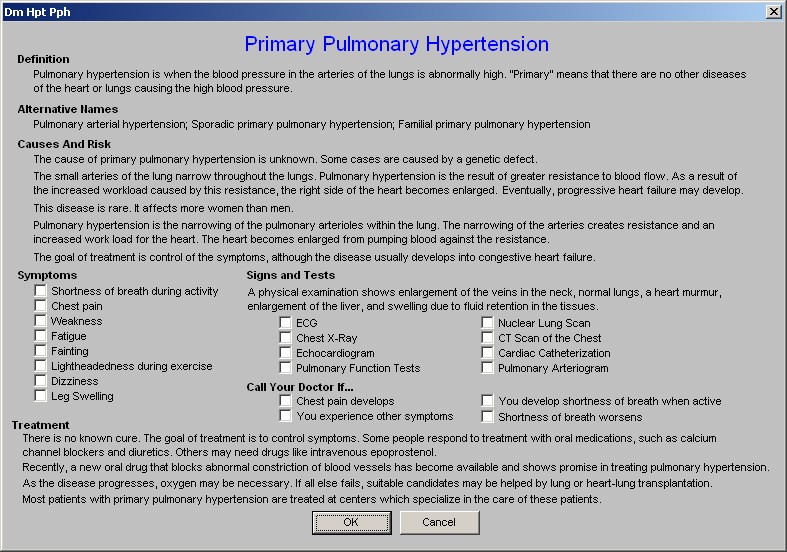|
Primary Pulmonary Hypertension is not a part of systemic hypertension but is presented here because of the close association of the name. To see this tutorial as it appears in our EMR, click here

- Definition -- Pulmonary hypertension is when the blood pressure in the arteries of the lungs is abnormally high. "Primary" means that there are no other diseases of the heart or lungs causing the high blood pressure.
- Alternative Names -- Pulmonary arterial hypertension; Sporadic primary pulmonary hypertension; Familial primary pulmonary hypertension
- Causes And Risk -- The cause of primary pulmonary hypertension is unknown. Some cases are caused by a genetic defect.
- The small arteries of the lung narrow throughout the lungs. Pulmonary hypertension is the result of greater resistance to blood flow. As a result of the increased workload caused by this resistance, the right side of the heart becomes enlarged.
- This disease is rare. It affects more women than men.
- Pulmonary hypertension is the narrowing of the pulmonary arterioles within the lung. The narrowing of the arteries creates resistance and an increased work load for the heart. The heart becomes enlarged from pumping blood against the resistance.
- The goal of treatment is control of the symptoms, although the disease usually develops into congestive heart failure.
- Symptoms
- Shortness of breath during activity
- Chest pain
- Weakness
- Fatigue
- Fainting
- Lightheadedness during exercise
- Dizziness
- Leg Swelling
- Signs and Tests
- A physical examination shows enlargement of the veins in the neck, normal lungs, a heart murmur, enlargement of the liver, and swelling due to fluid retention in the tissues.
- Tests
- ECG
- Chest X-Ray
- Echocardiogram
- Pulmonary Function Tests
- Nuclear Lung Scan
- CT Scan of the Chest
- Cardiac Catheterization
- Pulmonary Arteriogram
- Call Your Doctor If...
- Chest pain develops
- You develop shortness of breath when active
- Shortness of breath worsens
- You experience other symptoms
- Treatment
- There is no known cure. The goal of treatment is to control symptoms. Some people respond to treatment with oral medications, such as calcium channel blockers and diuretics. Others may need drugs like intravenous epoprostenol.
- Recently, a new oral drug that blocks abnormal constriction of blood vessels has become available and shows promise in treating pulmonary hypertension.
- As the disease progresses, oxygen may be necessary. If all else fails, suitable candidates may be helped by lung or heart-lung transplantation.
- Most patients with primary pulmonary hypertension are treated at centers which specialize in the care of these patients.


If you think the patient has Primary Pulmonary Hypertension, check the box beside that name and the following will automatically have the boxes beside them checked:
- Chest Film
- Chest CT
- ECG
- Echocardiogram
- Nuclear Lung Scan
- Pulmonary Arteriogram
- Pulmonary Function Testing
| 



